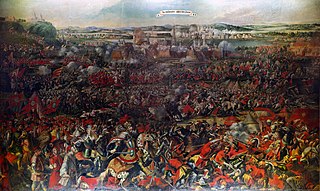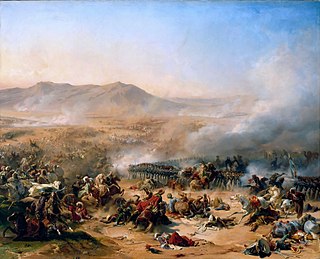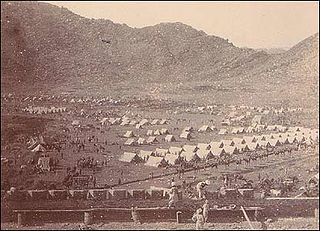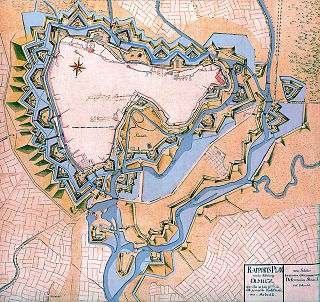Related Research Articles

A siege is a military blockade of a city, or fortress, with the intent of conquering by attrition, or a well-prepared assault. This derives from Latin: sedere, lit. 'to sit'. Siege warfare is a form of constant, low-intensity conflict characterized by one party holding a strong, static, defensive position. Consequently, an opportunity for negotiation between combatants is not uncommon, as proximity and fluctuating advantage can encourage diplomacy. The art of conducting and resisting sieges is called siege warfare, siegecraft, or poliorcetics.

The Sikorsky MH-60G/HH-60G Pave Hawk is a twin-turboshaft engine helicopter in service with the United States Air Force. It is a derivative of the UH-60 Black Hawk and incorporates the US Air Force PAVE electronic systems program. The HH-60/MH-60 is a member of the Sikorsky S-70 family.

The Battle of Vienna took place at Kahlenberg Mountain near Vienna on 12 September 1683 after the imperial city had been besieged by the Ottoman Empire for two months. The battle was fought by the Holy Roman Empire led by the Habsburg Monarchy and the Polish–Lithuanian Commonwealth, both under the command of King John III Sobieski, against the Ottomans and their vassal and tributary states. The battle marked the first time the Commonwealth and the Holy Roman Empire had cooperated militarily against the Ottomans, and it is often seen as a turning point in history, after which "the Ottoman Turks ceased to be a menace to the Christian world". In the ensuing war that lasted until 1699, the Ottomans lost almost all of Hungary to the Holy Roman Emperor Leopold I.

The Battle of Korsun–Cherkasy, or the battle of the Korsun–Cherkasy pocket, was a World War II battle fought from 24 January to 16 February 1944 in the course of the Soviet Dnieper–Carpathian offensive in Ukraine following the Korsun–Shevchenkovsky offensive. In the battle, the 1st and 2nd Ukrainian Fronts, commanded, respectively, by Nikolai Vatutin and Ivan Konev, encircled German forces of Army Group South in a pocket near the Dnieper River. During weeks of fighting, the two Red Army Fronts tried to eradicate the pocket. The encircled German units attempted a breakout in coordination with a relief attempt by other German forces, resulting in heavy casualties, estimates of which vary.

The Siege of Metz was a battle fought during the Franco-Prussian War from August 19 to October 27, 1870 and ended in a decisive Allied German victory.

The siege of Lucknow was the prolonged defence of the Residency within the city of Lucknow during the Indian Rebellion of 1857. After two successive relief attempts had reached the city, the defenders and civilians were evacuated from the Residency, which was then abandoned.

The Battle of St. Quentin was a battle of the Franco-Prussian War in which Prussian forces defeated French attempts to relieve the besieged city of Paris.

A breakout is a military operation to end a situation of investment by offensive operations that achieve a breakthrough—escape from offensive confinement. It is used in contexts such as this: "The British breakout attempt from Normandy". It is one of four possible outcomes of investment, the others being relief, surrender, or reduction.
The Battle of Chiset also known as the Battle of Chizai or Battle of Chizé was fought at Chizé on 21 March 1373 between English and French forces during the Hundred Years War. The French had laid siege to the town and the English sent a relief force. The French, led by Bertrand du Guesclin, met the relief force and defeated it.

The Johannesburg Light Horse Regiment, is a reserve armoured car reconnaissance unit of the South African Army.
The State Protection Group (SPG) is part of the Counter Terrorism & Special Tactics Command of the New South Wales Police Force and was established in 1991 to deal with extraordinary policing responses. The SPG directly supports police in high-risk incidents such as sieges with specialised tactical, negotiation, intelligence and command-support services. The unit also provides rescue and bomb disposal support, canine policing, and armoury services.

The Battle of Mount Tabor was fought on 16 April 1799, between French forces commanded by Napoleon Bonaparte and General Jean-Baptiste Kléber, against an Ottoman Army under Abdullah Pasha al-Azm, ruler of Damascus. The battle was a consequence of the siege of Acre, in the later stages of the French Campaign in Egypt and Syria.

The siege of Malakand was the 26 July – 2 August 1897 siege of the British garrison in the Malakand region of colonial British India's North West Frontier Province. The British faced a force of Pashtun tribesmen whose tribal lands had been bisected by the Durand Line, the 1,519 mile (2,445 km) border between Afghanistan and British India drawn up at the end of the Anglo-Afghan wars to help hold back what the British feared to be the Russian Empire's spread of influence towards the Indian subcontinent.

The Siege of Cádiz was a siege of the large Spanish naval base of Cádiz by a French army from 5 February 1810 to 24 August 1812 during the Peninsular War. Following the occupation of Seville, Cádiz became the Spanish seat of power, and was targeted by 70,000 French troops under the command of the Marshals Claude Victor and Nicolas Jean-de-Dieu Soult for one of the most important sieges of the war. Defending the city were 2,000 Spanish troops who, as the siege progressed, received aid from 10,000 Spanish reinforcements as well as British and Portuguese troops.

The siege of Plei Me was the beginning phase of the first major confrontation between soldiers of the North Vietnamese People's Army of Vietnam (PAVN) and the U.S. Army during the Vietnam War. The lifting of the siege by South Vietnamese forces and American air power was followed by the pursuit of the retreating North Vietnamese from 28 October until 12 November, setting the stage for the Battle of Ia Drang.

The siege of Olomouc took place in 1758 when a Prussian army led by Frederick the Great besieged the Austrian city of Olmütz during the Prussian invasion of Moravia in the Third Silesian War. The attempt stalled as the besiegers faced stronger resistance than Frederick had expected. With a lack of supplies and the approach of an Austrian relief force following the Battle of Domstadtl, Frederick abandoned the siege and withdrew from Moravia.
A reduction, in military tactics, is accomplished when an encircling force conducts successful offensive operations over an invested force. The "reduction" refers to the shrinking in size of the pocket of territory occupied by the invested force, which would appear to be reduced as seen from a map. It is one of the four possible outcomes of investment, the others being relief, surrender or a breakout.

The siege of Grave was a siege that took place between 18 July to 20 September 1602, as part of the Eighty Years' War and the Anglo–Spanish War. The Spanish-held city of Grave was besieged by a Dutch and English army led by Maurice of Orange and Francis Vere respectively. After a siege of nearly two months the city surrendered when a Spanish relief army under Francisco de Mendoza was defeated just outside the city by the besiegers. The defeat was severe enough to cause a major mutiny in the Spanish army.

The siege of Coevorden was a siege that took place between 26 July and 2 September 1592 during the Eighty Years' War and the Anglo–Spanish War at the city of Coevorden by a Dutch and English force under overall command of Maurice of Nassau. The city was defended by Frederik van den Bergh who had been commissioned for the defence by King Philip II of Spain.
A sortie is a deployment or dispatch of one military unit, be it an aircraft, ship, or troops, from a strongpoint. The term originated in siege warfare.